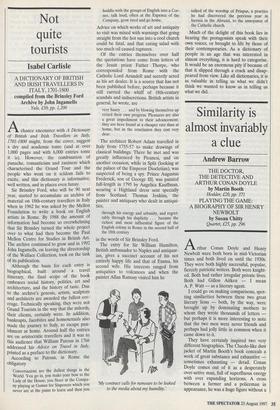Not quite tourists
Isabel Carlisle
A DICTIONARY OF BRITISH AND IRISH TRAVELLERS IN ITALY, 1701-1800 compiled from the Brinsley Ford Archive by John Ingamells Yale, £50, pp. 1,200 Achance encounter with A Dictionary of British and Irish Travellers in Italy, 1701-1800 might, from the cover, suggest a dry and academic tome (and at over 1,000 pages and with 6,000 entries tome it is). However, the combination of panache, romanticism and zaniness which characterised the Grand Tour and the people who went on it seldom fails to excite, and this dictionary is informative, well written, and in places even funny. Sir Brinsley Ford, who will be 90 next year, started to accumulate an archive of material on 18th-century travellers in Italy when in 1962 he was asked by the Mellon Foundation to write a book on English artists in Rome. By 1988 the amount of information had become so overwhelming that Sir Brinsley turned the whole project over to what had then become the Paul Mellon Centre for Studies in British Art. The archive continued to grow and in 1992 John Ingamells, on leaving the directorship of the Wallace Collection, took on the task of its publication. Although the basis for each entry is biographical, built around a travel itinerary, the final scope of the book embraces social history, politics, art and architecture, and the history of taste. Due to the archive's genesis, artists, sculptors and architects are awarded the fullest cov- erage. Technically speaking, they were not Grand Tourists in the way that the milords, their clients, certainly were. In addition, bankrupts, Jacobites and homosexuals also made the journey to Italy, to escape pun- ishment at home. Around half the entries are on aristocratic travellers and it was to this audience that William Patoun in 1766 addressed his Advice on Travel in Italy, printed as a preface to the dictionary. According to Patoun, in Rome the obligatory
Conversazioni are the dullest things in the World. You go in, you make your bow to the Lady of the House, you Stare at the Compa- ny playing at Games for Sixpences which you never are at the pains to learn and then you huddle with the groups of English into a Cor- ner, talk loud, often at the Expence of the Company, grow tired and go home.
Advice on which works of art and antiquity to visit was mixed with warnings that going straight from the hot sun into a cool church could be fatal, and that eating salad with too much oil caused ruptures.
Of the entries themselves over half the quotations have come from letters of the Jesuit priest Father Thorpe, who corresponded from Rome with the Catholic Lord Arundell and secretly acted as his art dealer. It is a source that has not been published before, perhaps because it still carried the whiff of 18th-century scandals and indiscretions. British artists in general, he wrote, are
very Saucy . . . and by blowing themselves up retard their own progress. Pleasures are also a great impediment to their advancement; they are here found at a cheaper rate than at home, but in the conclusion they cost very dear.
The architect Robert Adam travelled in Italy from 1755-57 to make drawings of classical buildings. There he met and was greatly influenced by Piranesi, and on another occasion, while in Split (looking at the palace of the Emperor Diocletian), was suspected of being a spy. Prince Augustus Frederick, son of George III, was painted full-length in 1795 by Angelica Kauffman, wearing a Highland dress sent specially from Scotland. Thomas Jenkins, the painter and antiquary who dealt in antiqui- ties,
through his energy and urbanity, and regret- tably through his duplicity . . . became the richest and most influential figure of the English colony in Rome in the second half of the 18th century
in the words of Sir Brinsley Ford.
The entry for Sir William Hamilton, British ambassador to Naples and antiquar- ian, gives a succinct account of his not entirely happy life and that of Emma, his second wife. His interests ranged from antiquities to volcanoes and when the painter Allan Ramsay visited him he My contract calls for rumours to be leaked to the media about my humility.'
talked of the worship of Priapus, a practice he had discovered the previous year in Isernia in the Abruzzi, to the annoyance of the Catholic church.
Much of the delight of this book lies in hearing the protagonists speak with their own voices, or brought to life by those of their contemporaries. As a dictionary of people in an age that was interested in almost everything, it is hard to categorise. It would be an enormous pity if because of that it slipped through a crack and disap- peared from view. Like all dictionaries, it is as valuable in telling us what we didn't think we wanted to know as in telling us what we did.


























































 Previous page
Previous page